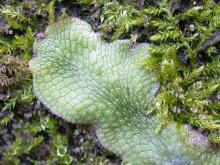Mosses, Liverworts, and Lichens
Media

Species Types
Scientific Name
About 112 species in Missouri
Description
Liverworts, along with mosses, make forest floors, streamsides, and spring openings beautiful. They’re fascinating but overlooked.
Media

Species Types
Scientific Name
Frullania eboracensis
Description
New York scalewort is the most common and easily recognized leafy or scaly liverwort. It forms tiny, delicate traceries on tree bark and is usually rusty or purplish red or green.
Media

Species Types
Scientific Name
Thuidium spp.
Description
Easy to identify, fern mosses look like tiny ferns. Just like many fern fronds, the branches lie on one plane and become shorter toward the tips. They even lean over like fern fronds.
Media

Species Types
Scientific Name
Parmotrema spp.
Description
Ruffle lichens are rather large, broad-lobed foliose lichens that are loosely attached to the substrate. The rounded edges of the lobes usually lift up and look ruffled. Hairlike cilia arise from the lobe edges. They usually grow on tree bark.
Media

Species Types
Scientific Name
Peltigera canina
Description
Dog tooth lichen, Peltigera canina, is a foliose lichen that usually grows on soil. It’s common and easy to identify. The spore-bearing structures are rusty brown and rolled, standing upright at the lobe tips.
Media

Species Types
Scientific Name
Acarospora spp.
Description
Cobblestone lichens , or cracked lichens, grow flat against their substrate and are textured like lumpy cobblestone streets or old, cracked paint, or they are broken into sections like the mud of a dried lake. Depending on species, the color can range from white to greenish gray to brown to bright yellow.
Media

Species Types
Scientific Name
About 436 species in Missouri
Description
A lichen is a composite organism formed by certain fungus species that join with certain algae species. Lichens can be many colors and can be crusty, leaflike, flaky, branching, or mossy. They grow on rocks, trees, or other surfaces.
Media

Species Types
Scientific Name
Caloplaca spp.
Description
Firedot lichens are usually orange, yellow, rusty, or brown and look like tiny dots on a surface. To see these crustose lichens well, you often must get on your hands and knees and use a hand lens.
Media

Species Types
Scientific Name
Lecanora spp.
Description
Rim lichens have mostly disk-shaped apothecia (spore-bearing structures) encircled by noticeable rims that are the same color as the rest of the lichen body. This is a large group, plus there are lots of lookalikes.
Media

Species Types
Scientific Name
Climacium americanum and Climacium kindbergii
Description
Tree mosses in genus Climacium look like miniature trees, complete with tiny upright trunks and long, slender branches clustered at the top. They form dense, thick mats in moist, shady places.
See Also
About Mosses, Liverworts, and Lichens in Missouri
Mosses, liverworts, hornworts, and lichens seem rather similar, but these organisms are in very different groups. Mosses, liverworts, and hornworts are small, low plants usually found in damp habitats. Unlike more familiar plants, they lack veinlike structures and do not produce flowers or seeds — instead, they produce spores. Meanwhile, lichens are not plants at all: they are a collection of different fungi that have photosynthetic algae living within their tissues.





















